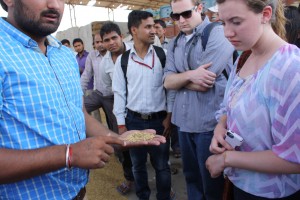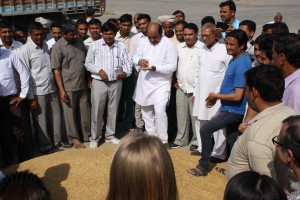By Katie Janson and Elayna Kramer, Supply Chain Management students at the University of Illinois at Urbana-Champaign
The following post was written by students on an ADM Institute-sponsored observation study tour through India in March 2015.
While interviewing the farmers in Chennai, we kept hearing about a “middleman,” but we never had the pleasure of conversing with one. When we traveled to Madlauda to interview workers at the commissioner’s office and some of the local farmers, we finally had the chance to pick the mind of the elusive middleman. The middlemen, or commissioners, not only have an important role in the supply chain but also contribute in their own special way to postharvest loss.
During our time at the office, we discovered that commissioners play several roles. Firstly, a commissioner is a buyer. Farmers can choose to sell directly to a wholesale market or they can choose to sell their goods to a middleman. While farmers and commissioners do not have especially long-lasting, personal relationships, it is advantageous for them to sell to commissioners because of their second purpose, banking.
Commissioners can pay a cash advance to farmers before they even receive the goods, serving as loans for their farms. Even though this serves as a great risk for the commissioners—the farmers may not fulfill their contracts—the loans they give farmers are essential in financing.
In addition, a commissioner stores the goods, usually at the commissioner’s office itself, for about one week. Interestingly, the commissioner we spoke with claimed there was 0% loss during the storage process. However, due to factors such as pests, insects, nonseasonal rains, and other uncontrollable conditions, we students during our interviews have found this statement to be highly unlikely.

A commissioner explains how quality factors can impact access to export markets to Katie and the group. Credit: ADMI/K.Wozniak
Lastly, commissioners serve as sellers to exporters. Commissioners receive a 2.5% commission from the government on each sale. However, at times commissioners are unable to sell to exporters. Each exporter has its own set of quality controls, and if the commissioner’s goods do not meet the standards (due to factors such as too much moisture or low quality in general), those exporters will not purchase the goods. Recently, Indian commissioners have struggled selling their goods to Iran and Iraq because of those very same reasons. Also, just as there is risk in financing farmers, commissioners face risk when dealing with exporters; exporters may not accept their goods upon sale.
In the end, commissioners have the potential to find great success. If their farmers pay them back, no goods are lost in storage, and exporters buy their goods, then they have the potential to make a great profit. Not only can they earn interest from the farmers and make a profit from selling to exporters, but they also receive commission from the government. These multiple streams of income can prove very beneficial to these middlemen.
Despite the benefits a commissioner may find, postharvest loss still occurs despite claims that it does not. Our interview with the commissioner was yet another example of how pointing fingers is a common theme regarding postharvest loss. The farmers say that the harvesters are the ones to blame. The harvesters say the middlemen lose the goods in transportation. The commissioners say that farmers lose goods during storage. No party claims to play an important role in loss. It seems that while some have begun to recognize that loss is a problem, no one is yet willing to claim their stake in the problem. It is not until this ownership ensues that postharvest losses will really begin to decrease.
Katie and Elayna are participants in the 2015 Supply Chain Management India study abroad trip organized by the program director in the College of Business at the University of Illinois at Urbana-Champaign, Professor Udatta Palekar. Throughout the 10-day trip, students observe how agricultural products in India move through supply chains from farm to consumer with a special focus on postharvest losses.
Read more blogs in this series:
Hearing from Locals on Farming in South India: Day 1
Things are Heating Up in India: Day 2
What Seeing a World Wonder was Like: Day 5



No comments yet.